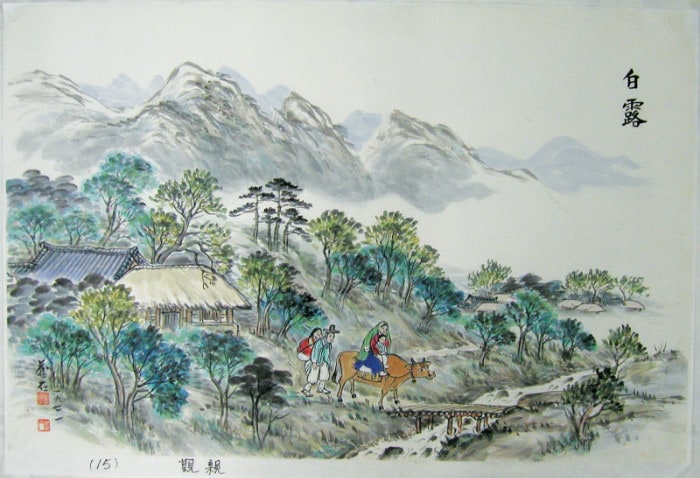The day of Baengno (백로, 白露), literally “White Dew,” falls on Wednesday, Sept. 7, this year. It is the 15th of 24 solar terms of the year. It always falls between Cheoseo (처서, 處暑), the End of the Heat, which was on Aug. 23, and Chubun (추분, 秋分), the autumn equinox, which will be on Sept. 22.
In the Gregorian calendar, Baengno generally runs from around Sept. 7 or 9 until around Sept. 23, and the Chuseok Mid-Autumn Festival is always celebrated around this time of year. By the lunar calendar, Baengno‘s normally in the eighth lunar month of the year.
The name “White Dew” derives from the observation that, generally at around this time of year, temperatures in the morning begin to fall below the dew point, with dew forming on tree leaves and grass overnight.
By the ancient East Asian calendar, the period between Baengno and the autumn equinox was divided into three five-day periods. The first period was described as the time when wild geese returned home. The second, when swallows began their southward journey. The third, when birds gathered food for winter.

Baengno falls on Wednesday, Sept. 7, this year and marks the day when temperatures in the morning begin to fall below the dew point.
Baengno occurs after the rainy season, when the skies have cleared. Occasional typhoons and high tidal waves can occur at this time of year, and these events can damage crops. Traditionally, farmers in Jeollanam-do Province would consider it a bad omen if the first frost were to be seen before Baengno. The weather-conscious farmer would also believe that, for the year’s rice harvest to be successful, the grain must finish ripening beforeBaengno.
The year’s first frost is usually followed by frigid winds and a significant drop in temperature. Rice plants that only started bearing grain late in the season often do not mature fully, and this can eventually translate into poorer crop yields.
As the weather at Baengno can significantly affect the harvest, farming households in ancient times would carefully observe weather changes during this period. In particular, any windy weather on or around Baengnowould be considered an indicator of potential crop damage.
This article is made possible through content provided by the Encyclopedia of Korean Folk Culture.
By Gregory C. Eaves
Korea.net Staff Writer
Photos: Encyclopedia of Korean Folk Culture
gceaves@korea.kr























